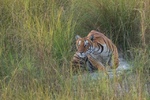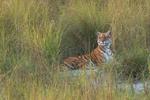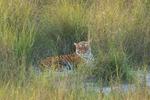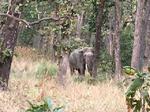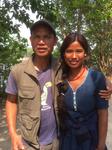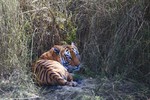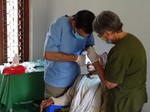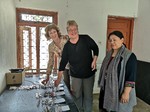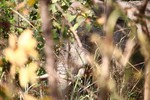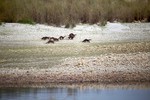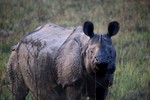
The Nepal Bardia Expedition 2019
A Summary
Helen freefall parachutes, crews yachts and rides thoroughbreds; however, mounted on a 4 ton government elephant in the riverine scrub of the Bardia National Park in West Nepal, she had a totally new experience.
“Moving at a steady, lumbering gait we heard a low cough coming from a bush and then with a blood curdling roar a ten foot Royal Bengal Tigress charged us, fangs bared and making a hell of a din. Our elephant went into fast retreat leaving the huge cat snarling at us before it turned away and disappeared into the long grass. It was the most memorable sight of my life” said the tough Yorkshire lady “we presumed the tigress had cubs nearby and was simply being protective, however it was a once in a lifetime experience”.
This was the first of many encounters our expedition was to have with the “Queen of the Jungle” as the tiger are known.
The 20 strong expedition was carrying out wildlife counts and aiding the local community at the suggestion of the wildlife authorities in this remote park in the lowlands of Western Nepal. Our team included two doctors, a dentist, two retired nurses, a surveyor, a chemist, a retired police officer, a former banker, and engineer and a fingerprint expert.
Co-ordinating the wildlife study was environmentalist Professor Alastair Driver of Exeter University. We also had a young lady from Dorset who plans to be a wildlife photographer.
Our ages varied from 23 to 82 and most had been together on previous expeditions elsewhere in the world.
Mounted on five government domestic elephants kindly provided by the Park Director and 3 four wheel drive cars, they spent nine days combing the sal forests, jungle and grasslands.
A splendid tented camp had been set up by nature lover Rajan Chaudhary and his pals who are dedicated to the conservation of the fauna and flora of the area and acted as our guides. They pride themselves on knowing the names of all the birds, mammal and reptiles of this unique 1500 square kilometre park. Now they have formed themselves into the Bardia Nature Conservation Club (BNCC) to support the Wildlife Department and protect the park. Part of their programme is to educate the local children, many of whom have never actually been inside the park, to protect the animals and in particular to curb poaching.
Thus it was Rajan’s suggestion that the team undertook to refurbish and re-equip a primary school. Thanks to the generous help of the Newport Uskmouth Rotary Club and members of the Scientific Exploration Society funds were raised for this. The novelist, Anna Nicholas, a former trustee of the Society even ran a marathon to bring in money.
Dr João Branco, a Portuguese dentist who had also been with us on the 2018 expedition in Kenya joined us again and ran clinics, extracting some 70 teeth from people who rarely see a dentist. We also gave out reading glasses to those in need.
The population of tiger certainly seems to have increased since our 2012 expedition and we also located some fine one-horned Indian rhinos. Strangely the large wild elephants for which Bardia is famous were not as evident. We did find two tuskers with the same domed heads similar to the legendary giant elephant Raja Gaj that we had first located in 1992, that was mistakenly thought to be a mammoth. However we were not able to find the main herd and especially cows and believe they have possibly moved into the Eastern extension of the park which we were unable to cover in the time available.
Using inflatable rafts we floated for a few hours down the Karnali River where to her joy, photographer Natalie Bourchier spotted a tiger enjoying itself rolling in the sand on the bank whilst a group of spotted deer browsed only fifty yards away. Presumably the tiger had already lunched!
One of our Nepalese naturalists, Deepak Rajbanshi, has become a most accomplished photographer and managed to get some outstanding photos of tiger and a troop of playful otters.
Our bird watchers also had a success in seeing 152 species, higher than the 148 we had spotted on previous expeditions in Bardia.
In spite of Bardia being a wildlife paradise the local people have often suffered as a result and we were able to make some cash grants to assist a few including Padam Birthapa whose baby daughter was dragged from his house by a man eating 7 foot crocodile known as a mugger. Padam, his wife and two other children dived into the water and managed to force the reptile’s jaws apart and pull the baby to safety. However, all sustained terrible injuries.
We also gave some more assistance to Mrs Pariyar and her family. In 2012 we had helped to educate her three children after their father was killed by a wild tusker smashing into his farm to steal grain.
To encourage children to respect and protect the wildlife of Bardia animal puppets made by groups of ladies in Dorset were distributed and binoculars collected by Shirley Critchley of Poole were presented to wardens and guides in the park.
A full report will now be produced and will include an updated map of the Western side of the park made by our surveyor Tim Harrison.
The expedition ended with our traditional Burns supper complete with Stahly’s tinned haggis and a few drams. Jennifer Ellenger of Jersey organised the entertainment with acts by ourselves and our Nepalese friends. The final event was a race game using cardboard elephants made by Sue Hilliard, who had made several previous visits to Bardia.
Although our flight back to Kathmandu on the splendidly named Yeti airline was a little late, we all got back to the delightful Boutique Heritage Hotel in Kathmandu’s Patan area on 29th March. Fortunately, this historic building survived the terrible earthquake that struck Nepal in 2015.
Professor Alastair Driver who co-ordinated the wildlife studies commented “The Bardia expedition was a truly memorable experience for me thanks to our superb local guides, not only because I achieved a lifetime ambition of seeing tigers close up in the wild, but also because we notched up over 150 bird species, 18 mammals and 9 reptiles and secured many high quality images of butterflies, dragonflies etc which I now aim to identify to add to the National Park records.”
“The expedition proved to be a real success and hopefully will be of value to the Bardia National Park” said Colonel John Blashford-Snell who led the expedition.
For more information, please do contact us.
